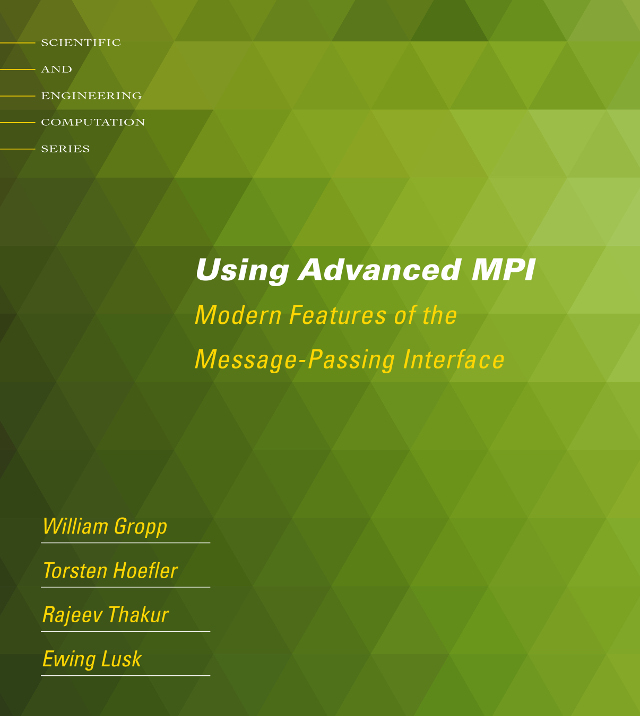Our book on “Using Advanced MPI” will appear in about a month — now it’s the time to pre-order on Amazon at a reduced price. It is released by the prestigious MIT Press, a must read for parallel computing experts.
The book contains everything advanced MPI users need to know. It presents all important concepts of MPI 3.0 (including all newly added functions such as nonblocking collectives and the largely extended One Sided functionality). But the key is that the book is written in an example-driven style. All functions are motivated with use-cases and working code is available for most. This follows the successful tradition of the “Using MPI” series lifting it to MPI-3.0 and hopefully makes it an exciting read!
David Bader’s review hits the point
With the ubiquitous use of multiple cores to accelerate applications ranging from science and engineering to Big Data, programming with MPI is essential. Every software developer for high performance applications will find this book useful for programming on modern multicore, cluster, and cloud computers.
Here is a quick overview of the contents:
Section 1: “Introduction” provides a brief overview of the history of MPI and briefly summarizes the basic concepts.
Section 2: “Working with Large Scale Systems” contains examples of how to create highly-scalable systems using nonblocking collective operations, the new distributed graph topology for MPI topology mapping, neighborhood collectives, and advanced communicator creation functions. It equips readers with all information to write codes that are highly-scalable. It even describes how fault-tolerant applications could be written using a high-quality MPI implementation.
Section 3: “Introduction to Remote Memory Operations” is a gentle and light introduction to RMA (One Sided) programming using MPI-3.0. It starts with the concepts of memory exposure (windows) and simple data movement. It presents various example problems followed by practical advice to avoid common pitfalls. It concludes with a discussion on performance.
Section 4: “Advanced Remote Memory Access” will make you a clear expert in RMA programming, it covers advanced concepts such as passive target mode, allocating MPI windows using various examples. It also discusses memory models and scalable synchronization approaches.
Section 5: “Using Shared Memory with MPI” explains MPI’s strategy to shared memory. MPI-3.0 added support for allocating shared memory which essentially enables the new hybrid programming model “MPI+MPI“. This section explains guarantees that MPI provides (and what it does not provide) and several use-cases for shared memory windows.
Section 6: “Hybrid Programming” provides a detailed discussion on how to use MPI in cooperation with other programming models, for example threads or OpenMP. Hybrid programming is emerging to a standard technique and MPI-3.0 introduces several functions to ease the cooperation with others.
Section 7: “Parallel I/O” is most important in the future Big Data world. MPI provides a large set of facilities to support operations on large distributed data sets. We discuss how MPI supports contiguous and noncontiguous accesses as well as the consistency of file operations. Furthermore, we provide hints for improving the performance of MPI I/O.
Section 8: “Coping with Large Data” once Big Data sets are in main memory, we may need to communicate them. MPI-3.0 supports handling large data (>2 GiB) through derived datatypes. We explain how to enable this support and limitations of the current interface.
Section 9: “Support for Performance and Correctness Debugging” is addressed at very advanced programmers as well as tool developers. It describes the MPI tools interface which allows to introspect internals of the MPI library. Its flexible interface supports performance counter and control variables to influence the behavior of MPI. Advanced expert programmers will love this interface for architecture-specific tuning!
Section 10: “Dynamic Process Management” explains how processes can be created and managed. This feature enables growing and shrinking of MPI jobs during their execution and fosters new programming paradigms if it is supported by the batch systems. We only discuss the MPI part in this chapter though.
Section 11: “Working with Modern Fortran” is a must-read for Fortran programmers! How does MPI support type-safe programming and what are the remaining pitfalls and problems in Fortran?
Section 12: “Features for Libraries” addresses advanced library writers and described principles how to develop portable high-quality MPI libraries.
